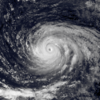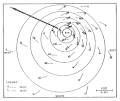Portal:Tropical cyclones
The Tropical Cyclones Portal

A tropical cyclone is a storm system characterized by a large low-pressure center, a closed low-level circulation and a spiral arrangement of numerous thunderstorms that produce strong winds and heavy rainfall. Tropical cyclones feed on the heat released when moist air rises, resulting in condensation of water vapor contained in the moist air. They are fueled by a different heat mechanism than other cyclonic windstorms such as Nor'easters, European windstorms and polar lows, leading to their classification as "warm core" storm systems. Most tropical cyclones originate in the doldrums, approximately ten degrees from the Equator.
The term "tropical" refers to both the geographic origin of these systems, which form almost exclusively in tropical regions of the globe, as well as to their formation in maritime tropical air masses. The term "cyclone" refers to such storms' cyclonic nature, with anticlockwise rotation in the Northern Hemisphere and clockwise rotation in the Southern Hemisphere. Depending on its location and intensity, a tropical cyclone may be referred to by names such as "hurricane", "typhoon", "tropical storm", "cyclonic storm", "tropical depression" or simply "cyclone".
Types of cyclone: 1. A "Typhoon" is a tropical cyclone located in the North-west Pacific Ocean which has the most cyclonic activity and storms occur year-round. 2. A "Hurricane" is also a tropical cyclone located at the North Atlantic Ocean or North-east Pacific Ocean which have an average storm activity and storms typically form between May 15 and November 30. 3. A "Cyclone" is a tropical cyclone that occurs in the South Pacific and Indian Oceans.
Selected named cyclone -
Extremely Severe Cyclonic Storm Sidr was a tropical cyclone that resulted in one of the worst natural disasters in Bangladesh. The fourth named and the deadliest storm of the 2007 North Indian Ocean cyclone season, Sidr formed in the central Bay of Bengal, and quickly strengthened to reach peak 1-minute sustained winds of 260 km/h (160 mph), making it a Category-5 equivalent tropical cyclone on the Saffir–Simpson scale. The storm eventually made landfall in Bangladesh on November 15, 2007, causing large-scale evacuations. At least 3,447 deaths have been blamed on the storm, with some estimates reaching 15,000.
Save the Children estimated the number of deaths associated with the cyclone to be between 3,100 and 10,000, while the Red Crescent Society reported on November 18 that the number of deaths could be up to 15,000. Other aid agencies have also estimated a death toll of up to 15,000. International groups pledged US$95 million to repair the damage, which was estimated at 196.25 billion taka (US$2.31 billion). (Full article...)
Selected article -
In Maryland and Washington, D.C., the effects of Hurricane Isabel were among the most damaging from a tropical cyclone in the respective metropolitan area. Hurricane Isabel formed from a tropical wave on September 6, 2003, in the tropical Atlantic Ocean. It moved northwestward, and within an environment of light wind shear and warm waters, it steadily strengthened to reach peak winds of 165 miles per hour (266 km/h) on September 11. After fluctuating in intensity for four days, Isabel gradually weakened and made landfall on the Outer Banks of North Carolina with winds of 105 miles per hour (169 km/h) on September 18. It quickly weakened over land and became extratropical over western Pennsylvania the next day.
On September 19, Tropical Storm Isabel passed through extreme western Maryland, though its large circulation produced tropical storm force winds throughout the state. About 1.24 million people lost power throughout the state. The worst of its effects came from its storm surge, which inundated areas along the coast and resulted in severe beach erosion. On the Eastern Shore, hundreds of buildings were damaged or destroyed, primarily in Queen Anne's County from tidal flooding. Thousands of houses were affected in Central Maryland, with severe storm surge flooding reported in Baltimore and Annapolis. Washington, D.C., sustained moderate damage, primarily from the winds. Throughout Maryland and Washington, damage totaled about $820 million (equivalent to $1.36 billion in 2023), with only one fatality due to flooding. (Full article...)
Selected image -

Selected season -

The 2020 North Indian Ocean cyclone season was the costliest North Indian Ocean cyclone season on record, mostly due to the devastating Cyclone Amphan. it was an above average season featuring 5 cyclonic storms. The North Indian Ocean cyclone season has no official bounds, but cyclones tend to form between April and November, with peaks in late April to May and October to November. These dates conventionally delimit the period of each year when most tropical cyclones form in the northern Indian Ocean. The season began on May 16 with the designation of Depression BOB 01 in the Bay of Bengal, which later became Amphan. Cyclone Amphan was the strongest storm in the Bay of Bengal in 21 years and would break Nargis of 2008's record as the costliest storm in the North Indian Ocean. The season concluded with the dissipation of Cyclone Burevi on December 5. Overall, the season was slightly above average, seeing the development of five cyclonic storms.
The scope of the season is limited to the Indian Ocean in the Northern Hemisphere, east of the Horn of Africa and west of the Malay Peninsula. There are two main seas in the North Indian Ocean – the Arabian Sea to the west of the Indian subcontinent, abbreviated ARB by the India Meteorological Department (IMD); and the Bay of Bengal to the east, abbreviated BOB by the IMD. (Full article...)
Related portals
Currently active tropical cyclones

Italicized basins are unofficial.
- North Atlantic (2024)
- No active systems
- East and Central Pacific (2024)
- No active systems
- West Pacific (2024)
- Tropical depression 28W
- North Indian Ocean (2024)
- No active systems
- Mediterranean (2024–25)
- No active systems
- South-West Indian Ocean (2024–25)
- No active systems
- Australian region (2024–25)
- No active systems
- South Pacific (2024–25)
- No active systems
- South Atlantic (2024–25)
- No active systems
Last updated: 16:12, 22 December 2024 (UTC)
Tropical cyclone anniversaries

December 25
- 1974 - Cyclone Tracy made landfall and passed directly over the city of Darwin, Australia. Tracy killed 71 people and caused catastrophic damage in and around the city.
- 2016 - Typhoon Nock-ten (pictured) makes landfall as a super typhoon over Bicol, Philippines, killing only 13 people. It was the strongest Christmas Day tropical cyclone worldwide.

December 26
- 2000 - Cyclone 04B (pictured) made landfall over Sri Lanka at peak intensity as a Category 1 tropical cyclone, making it the strongest cyclone to hit the island nation for nearly 25 years.
- 2001 - Tropical Storm Vamei formed to the east of Singapore at a latitude of 1.4° north, becoming the closest-forming tropical cyclone to the Equator.

- December 27, 2004 - Cyclone Chambo (pictured) reached its peak intensity with 155 km/h (100 mph) winds in the open Indian Ocean.
Did you know…




- …that the Joint Typhoon Warning Center considers that Typhoon Vera (pictured) of 1986 is actually two distinct systems, formed from two separated low-level circulations?
- …that Cyclone Freddy (track pictured) in 2023 was the longest-lasting tropical cyclone recorded?
- …that the typhoons of 2024—Yinxing, Toraji, Usagi, and Man-yi (pictured)—made history as the first recorded instance since 1951 of four tropical cyclones coexisting in November?
- …that Hurricane Otis (pictured) in 2023 was the first Pacific hurricane to make landfall at Category 5 intensity and surpassed Hurricane Patricia as the strongest landfalling Pacific hurricane on record?
General images -

The 2008 Atlantic hurricane season was an event in the annual tropical cyclone season in the north Atlantic Ocean. An above-average Atlantic hurricane season, it was the first on record to have a major hurricane in every month from July to November.
The season officially began on June 1, 2008, and ended on November 30, 2008, dates that conventionally delimit the period of each year when most tropical cyclones develop in the Atlantic basin. The season's first storm, Tropical Storm Arthur, formed on May 30, and the last, Hurricane Paloma, dissipated on November 10. Pre-season forecasts noted a high possibility for an above average number of tropical cyclones, primarily due to lingering La Niña effects and abnormally warm sea surface temperatures across the Atlantic basin. Altogether, 16 of the 17 tropical cyclones observed during the season developed into tropical storms. Of these, eight became hurricanes with five intensifying further into major hurricanes. With the exception of Tropical Storm Nana, every tropical cyclone during the season affected land to an extent. (Full article...)
Topics
Subcategories
Related WikiProjects
WikiProject Tropical cyclones is the central point of coordination for Wikipedia's coverage of tropical cyclones. Feel free to help!
WikiProject Weather is the main center point of coordination for Wikipedia's coverage of meteorology in general, and the parent project of WikiProject Tropical cyclones. Three other branches of WikiProject Weather in particular share significant overlaps with WikiProject Tropical cyclones:
- The Non-tropical storms task force coordinates most of Wikipedia's coverage on extratropical cyclones, which tropical cyclones often transition into near the end of their lifespan.
- The Floods task force takes on the scope of flooding events all over the world, with rainfall from tropical cyclones a significant factor in many of them.
- WikiProject Severe weather documents the effects of extreme weather such as tornadoes, which landfalling tropical cyclones can produce.
Things you can do
 |
Here are some tasks awaiting attention:
|
Wikimedia
The following Wikimedia Foundation sister projects provide more on this subject:
-
Commons
Free media repository -
Wikibooks
Free textbooks and manuals -
Wikidata
Free knowledge base -
Wikinews
Free-content news -
Wikiquote
Collection of quotations -
Wikisource
Free-content library -
Wikiversity
Free learning tools -
Wikivoyage
Free travel guide -
Wiktionary
Dictionary and thesaurus

























































